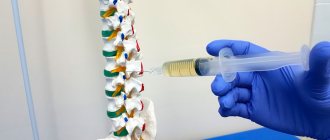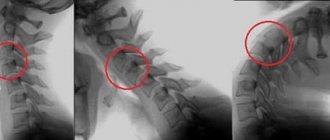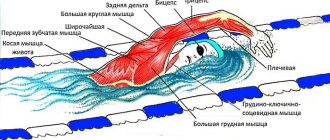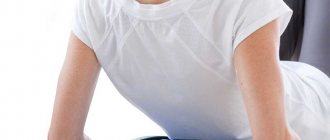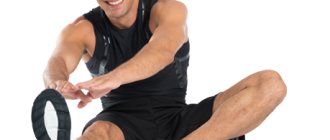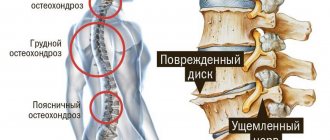For the treatment of spinal osteochondrosis, a set of exercises similar to fitness was developed in the twentieth century - Pilates
The urbanized modern world creates maximum convenience for its inhabitants - people.
In order to get to your place of work or study, it is enough to take a minibus, metro or even a personal car.
Most stores, including grocery stores, will deliver goods right to your door in a matter of hours.
Even in order to earn a living, there are many ways to do this without leaving your home chair, without leaving your home apartment.
These benefits of civilization are extremely convenient, saving time and effort. However, next to the plus there is always a minus. This minus is poor health caused by a decrease in physical activity. The world is filled with problems of obesity, metabolic disorders and spinal diseases.
In order to help the population maintain a healthy body, a lot of sports sections and gymnastic exercises of varying difficulty levels have been developed - activities designed to replenish muscle load.
One way to improve your health at the gym is Pilates.
What is Pilates?
Pilates exercises create a corset of muscles around the spine, increase the elasticity of muscle fibers, and restore flexibility to the spine
Pilates is a variation of fitness developed at the beginning of the last century. The lesson combines physical exercises for all leading muscle groups and breathing exercises. Pilates is suitable for almost every person of any age; it trains not only the body, but also makes the brain work.
Regular Pilates classes help achieve the following results::
- strengthen the muscles of the whole body, especially the back muscles;
- get a brain boost;
- saturate cells with oxygen;
- relieve stress;
- lose weight;
- form a neat, toned figure.
The lesson takes place without interruptions, the exercises are performed smoothly, measuredly, it is necessary to carefully monitor the rhythm of breathing.
The set of exercises is designed in such a way that even an elderly person can perform it, but at the same time this does not affect the effectiveness of the exercises.
Pilates for osteochondrosis
Pilates in the treatment of osteochondrosis shows excellent results, Pilates is especially effective in the treatment of osteochondrosis of the cervical spine
One of the main effects achieved by doing Pilates is strengthening the muscular corset of the back - supporting the spine.
With osteochondrosis, an uneven distribution of the load on the spine occurs; the parts affected by osteochondrosis are most severely affected.
The powerful muscle corset that occurs during Pilates classes allows you to unload the spine, distributing the load along its entire length.
In addition, Pilates classes include warm-up exercises that help restore the mobility of the spine affected by osteochondrosis.
Stretching exercises for the spinal muscles make them elastic, increasing the elasticity and strength of the spine.
Regular Pilates classes for patients diagnosed with osteochondrosis can slow down the development of the disease, reduce the manifestations of osteochondrosis and help restore the functions of the spine.
Therapeutic gymnastics program
Exercises can be different in focus. There are these types:
- To relax.
- Spinal traction.
- To strengthen muscles.
The training should begin with relaxation exercises. You can use breathing exercises. You can stretch the spine with the help of exercise therapy if you have diagnosed spondyloarthrosis of the thoracic region using a regular hang or half-hang on a horizontal bar. Strengthening can occur in this way:
- Lying on your stomach, place your palms on the floor at chest level. Lift your upper body, turning your head to the left at the top of the lift, then lower back down. Repeat, turning your head in the other direction. Only 15-20 repetitions.
- Standing on all fours, bend your back up, then down. At the same time, the neck continues the spine - do not tilt it back or forward. 15 to 20 repetitions.
- In the knee-elbow position, extend your left arm and right leg forward, hold in this position, then return back. Repeat, changing limbs, 15-20 times. Remember that exercises against spondyloarthrosis of the thoracic spine should not provoke pain.
Pilates as a preventive measure
Properly selected exercises when doing Pilates and distributing the load on the spine can prevent the development of osteochondrosis.
The set of exercises during Pilates classes is designed in such a way that the following effects on the spine are achieved: strengthening the muscular corset, training the elasticity of the ligaments and muscles of the spine, improving mobility of the spine, and establishing metabolism in the structures of the spine.
The last point successfully allows you to prevent the development of osteochondrosis, since with this disease the metabolism in the spine and surrounding tissues is greatly deteriorated - salt deposits form on the vertebral bodies, intervertebral discs become thinner, and the processes of regeneration of cartilage, muscle and bone tissue are greatly slowed down.
Useful video:
Regular Pilates classes minimize the risk of osteochondrosis.
Exercises for the lower back
When spending a long time without activity or physical exertion, pain attacks occur in the lumbar region. To relieve pain it is advised:
- Sitting on a flat surface, spread your legs to the sides, stretch your arms in front of you. The feet should face each other at a 90 degree angle. As you inhale, stretch your arms forward as much as possible, the spine rounds. As you exhale, the spine relaxes.
- It is recommended to sit on the floor and alternately pull the lower limbs towards the sternum. One leg is bent, the second is evenly extended along the surface.
Lying on the mat you can:
- imitate swimming, lifting your legs off the surface;
- lying on your back, bend your lower limbs at the knees and, as you exhale, strain your abs;
- Having relaxed the neck muscles, it is recommended to slowly raise the buttocks up, and at maximum height, take a deep breath, exhaling, lower the spine to the floor.
Doctors recommend doing exercises regularly, the result depends on the correctness of their implementation, which is aimed at stretching.
Exercises to treat hernia
Pilates for a hernia differs from training for healthy people. Classes should be conducted with a physical therapy specialist. Individual training is recommended, because each case of the development of a pathological process has its own characteristics.
It is prohibited to perform a set of exercises in the following cases:
- intense pain attacks;
- advanced form of the disease requiring surgical intervention;
- discomfort when trying to do the recommended exercise.
Once you start doing Pilates, you should understand that training should not be missed without good reason. They are held daily or every other day. Do not allow force or vertical loads on the spinal column.
Recommended exercises:
- Stand straight with your pelvis aligned. Drawing in your stomach, bend your pelvis inward. Hold the position for 10-15 seconds.
- Slowly twist the vertebra to a flat surface. When bending over, you need to separate the vertebrae as much as possible. When leveling, return to the starting position.
- Sitting comfortably on a hard surface, you need to slowly raise your body. The movements should begin from the tailbone. Finish the exercise by lifting your shoulder blades off the floor. Then carefully lower the body, gradually placing the vertebra in a level position.
When performing, you should repeat each action up to 15 times. You must keep your head straight. The lower abdomen should be as tense as possible, and the pelvis should be fixed. If you feel unwell and have a negative mood, it is better to reschedule classes to another time.
httpv://www.youtube.com/watch?v=embed/XUJCTWLgCjI
Pilates exercises for cervical osteochondrosis
Osteochondrosis of the cervical spine is extremely common. The special insidiousness of cervical osteochondrosis is that it affects the brain. Due to degeneration of the cervical vertebrae, partial or complete compression of the blood vessels supplying the brain occurs.
The blood flow to the head is disrupted, resulting in a lack of oxygen needed by the brain and the outflow of venous blood is disrupted, causing congestion of the brain vessels and increased pressure.
Outside periods of exacerbation of cervical osteochondrosis, doctors recommend Pilates classes to patients. This makes it possible to ensure adequate nutrition of the brain, prevent relapses of osteochondrosis, and even protect the patient from such dangerous complications as stroke.
Pilates classes for the treatment of cervical osteochondrosis are possible only after consultation with a doctor and must take place in the presence of a specialist. It is necessary to gradually increase the load, avoiding sudden fatigue when performing exercises.
Before the start of the lesson, warm-up exercises are carried out - they restore breathing, make rotational movements of the head, joints of the hands, elbows and shoulders.
After this, provided you feel well, begin the lesson. A set of exercises for cervical osteochondrosis includes 3 main points :
- Feet shoulder-width apart, back straight. Place your hands on your shoulders, trying to stretch your neck upward, while simultaneously pressing your hands on your shoulders. It is important to monitor your breathing: inhale smoothly, count to 15 in your head, then exhale smoothly. After completing the exercise, lower your arms and relax your muscles.
- The starting position does not change. The arms hang freely at the sides. Smooth rolls of the head from one shoulder to the other, then from front to back. During the exercise, it is important not to forget about slow, measured breathing.
- Legs wider than shoulders. Head tilts are performed alternately as quickly as possible: forward-backward, right-left. As you increase your speed, try to maintain your breathing rhythm.
When performing a set of exercises, it is important to concentrate all your attention on the exercises, feeling each muscle.
After starting Pilates classes, pain in the shoulders and arms may appear - this is normal - the blood supply to the spine improves, but you must report the occurrence of these symptoms to your doctor.
Efficiency of application
You can exercise at home, fitness clubs, and rehabilitation centers. The last option for cervical osteochondrosis is most preferable. Before starting training, the rehabilitation doctor must explain to the patient the basic principles of Pilates. The point of regular exercise is not athletic achievements, but the strengthening of certain muscle groups that will stabilize discs and vertebrae and prevent their displacement.
| Rules to follow during Pilates classes | Characteristics |
| "Rib" breathing | During classes, deep breathing is practiced, allowing you to move with lungs filled with air. It concentrates in the lower part of these respiratory organs, so the anterior sections do not expand, like the abdomen |
| Concentration, separation of body and mind | Physical and mental processes are combined during training. The better the patient concentrates on the muscles that need to be strengthened, the higher the quality of the exercises, and the process itself goes much faster. |
| Center | The energy source zone is the foundation, the main component of training. In Pilates, it refers to the area where the rectus and transverse abdominal muscles are located. It is from this zone that you need to take the energy necessary for training |
| Control and precision | During classes, a certain sequence of exercises is followed. That is, attention is focused not only on the muscles of the neck, but also on the adjacent muscles of the shoulder girdle and chest |
Reviews
Ira, 27 years old : I went to Pilates with a friend for company. Before the first training, the instructor asked about chronic diseases, I said that I had cervical osteochondrosis. She performed a separate complex specifically for my diagnosis. After 6 months of training, I noticed that headaches became much less frequent and my sleep improved. I recommend.
Alisa, 19 years old: Upon entering college, we noticed cervical osteochondrosis in the early stages. The doctor advised me to take up some kind of therapeutic exercise, so I went to Pilates. At first it was difficult to control my breathing, but I gradually got used to it. A few months later, at a follow-up examination, they said that they did not see osteochondrosis.
Symptoms
1. The main symptom of osteochondrosis is pain
.
With osteochondrosis, it can be: sharp (forces you to take a forced posture) and dull (restricts movement). 2. Feeling of numbness/ache in the arms and legs. 3. Pain when coughing/sneezing. 4. Muscle spasms/convulsions. 5. Dizziness, noise in the head, spots or colored spots before the eyes with a throbbing headache. 6. Sharp pain in the thoracic region. 7. Shooting pain in the lower back radiating to the sacrum. *It is important that the doctor is able to distinguish dull pain due to osteochondrosis from pain due to myositis of the back muscles.





